Satu Mare / Satmar is a city with a population of 130 thousand inhabitants1 which is situated in the north-western part of Romania. In the Romanian language ‘un sat’ means ‘a country, village’ and ‘mare’ means ‘big, large’. Thus, the name of the city could be translated as a ’Big Village’. Satu Mare is situated on the major road leading to the border crossing point with Hungary that is 15 kilometers away from the city. Should you happen to ‘cross’ the city one time, we highly recommend that you make a short stopover here in order to take a look at this beautiful place.
As many Transylvanian cities and towns, also Satu Mare is bilingual. (The Hungarian minority makes up circa 35 percent of the entire population). Interestingly, you may live here your all life long without even knowing the Romanian language. The Cable TV provides several dozen channels in Hungarian, in shops you are likely to hear the Romanian poftim and just after a while the Hungarian tasek (in English ‘May I help you, please?’) and in a theater the plays are performed in turns in two languages. What is more, it is quite pretty possible to finish the entire educational career in the Hungarian institutions or classes, to begin from kindergartens to the university, without knowing one single word in Romanian. This is historically determined; some Hungarians and their descendants have never accepted the fact that the city nowadays belongs to Romania. The cultivation of the language, of the Hungarian customs and habits as well as contesting everything that is Romanian is not a rare thing in here and it is a manifestation of disapproval and lacking acceptance to… what is Romanian. In the everyday contacts there is actually no love lost between these two nations.
The Someş River which falls into the river Cisa/Tisza in Hungary flows through the city. In 1970 the city and its surroundings were devastated by a flood; for this reason the city is now protected by large flood levees being visible in the picture below.
ATTENTION! Everyone who visited Romania or is planning to go there soon is kindly invited to contribute to this guide. Any inquires regarding this matter should be referred to the editor's address redakcja@libertas.pl.
A settlement in this place probably already existed in the Stone Age; the first written records concerning the city date back to the X century. In an anonymous chronicle the information can be found that there was a castle called Zotmar (Castrum Zotmar) in here which belonged to an Italian tribe headed by Menumorut.
In the XIII century the castle-town was conquered by Hungarians that used to call it Szatmar, and in the XIV century the king of Hungary - Karol I Robert - founded here a mint. Thanks to this step the significance of the city increased. In 1543 the castle was owned by the family Batorys; the same, from which the King Stefan IX Batory, by the Grace of God the King of Poland came.
After the First World War which finished with the decomposition of the Austria- Hungary the Romanians living in this part of the Empire took advantage of the good opportunity and proclaimed the annexation of the city to Romania. After that the city again belonged to Hungary for a short period during the Second World War as a result of the Second Vienna Award. In October 1944 it was captured by the Red Army and after the end of the Second World War 1945 it became again part of Romania.
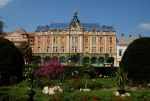
The most interesting monuments, buildings and pearls of architecture are to be seen in the neighborhood of the Liberty Square (Piaţa Libertăţii), in the middle of which there is a small park with valleys, benches and a big fountain. Taking a rest for a few minutes exactly in this place in summer heat might be a delicious experience! While walking through the park the tourists will easily come across the Hotel Dacia built in 1902 in the Art Noveau Style. It is said to be even more beautiful inside; however, we had no opportunity to take a closer look at the hotel due to its renovation.
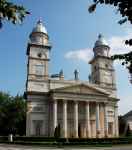
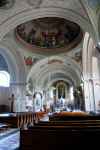
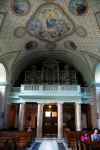
While sightseeing the tourists will also hardy miss the Saints Peter and Paul Cathedral overwhelming the Square. The Cathedral was built between 1786-1798 in the late baroque style; later a classical arcade supported on the Corinth Columns was attached. Also the lavishly embellished interior of the cathedral is worth the attention; it would be a sin not to come inside.
At the northeast corner of the square the tourists will come across the small classical North Theater from 1889 which however needs renovation. North of the square the tourists will see the Fireman’s Tower (Turnul Pompierilor) built in 1904 from which they can also enjoy the panorama of the city.
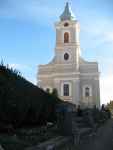
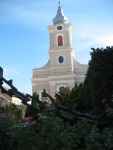
Within walking distance, near to the Peace Square (Piaţa Păcii), there is an evangelic church popularly and commonly called Chain Church. It is surrounded by a setting of small columns among which a heavy chain was overstretched that was the reason why the church was called like this. The church was built at the end of the XVIII century in baroque style. On the tower there is the oldest bell dating to 1633, the Bell of Satu Mare. The wooden furniture was made between 1799-1807 by Frits Joseph.
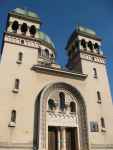
While walking along the 1 Decembrie 1918 street, east of the Liberty Square the tourists will come across the Orthodox Church of Archangels Michael and Gabriel built between 1932-1937 in the Romanian-Byzantine style and situated in the place of the former church. In the church there is a very rich collection of liturgical equipment, old books and volumes as well as icons; the oldest ones date back to the XVIII century.
Walking further the tourists will reach the intersection with the Boulevardul Dr. Vasile Lucaciu at which the Orthodox Church of Assumption is situated also built between 1932-37 in the characteristic Romanian style.
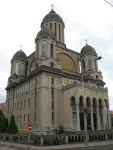
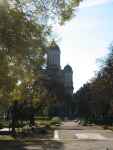
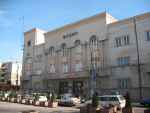
Also the Museum (Muzeul Judeţean) situated only 200 meters north of the Cathedral of Assumption (Bulevardul Dr. Vasile Lucaciu 21) is worth visiting. In the museum there is a large and interesting ethnographic exhibition of the region.
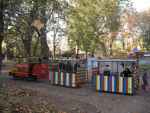
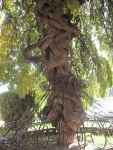
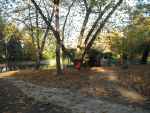
Behind the museum we turn right into Bulevardul Traian. If we have time enough, it is worth to walk this street 200-300 meters along to see the old, beautiful park Gradina Romei. The big, old commons truly deserve a note. One can take a rest on a small island on the lake; in season it could be a really nice experience for the tourists to ‘drive them crazy’ in the children’s train. If you are with your kids, there is a nice playground (with toilets and water) in here.
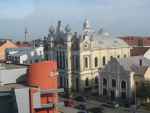
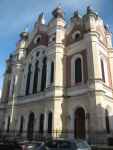
West of the Liberty Square there is the Old Synagogue and walking along the Decebal street, in northern direction from the Square, we will reach the synagogue Tempel built in the Mauritanian Style. It was erected at the beginning of the XX century and functioned till 1965. At the beginning of the Second World War the population of Jews in Satu Mare was about 25 thousand.
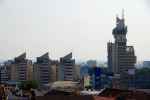
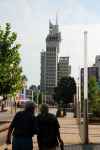
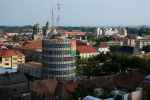
With the beautiful, architecture of the Square built in the Art Nouveau Style the so-called Szatmar Manhattan visibly contrasts. We can reach it walking along a promenade (pedestrian zone) beginning at the southwest corner of the Square. The Administrative Palace (Palatul Administrativ) hardly attempting to get finally rid of complexes from the Socialist Era is a building being as tall as ugly. The city was ‘given’ the building as a ‘gift’ by the former First Secretary of the Romanian Communist Party - Nicolae Ceauşescu and the Communist Party of Romania that wanted to make the panorama of the city more modern. The Palace began to be built in 1972 and was finished in 1984. The tallest tower is 97 meters high and it is, therefore, the tallest building in Transylvania and the third tallest building in Romania. Three smaller towers symbolize three nationalities of Satu Mare: the Romanians, Hungarians and Germans. (the Germans only make up circa 4% ); the tallest tower was meant to symbolize their solidarity.
On Tuesdays (except summer) the tourists can visit the concert hall for philharmonic music (the entry is not far away from the Fireman’s Tower). Due to its interior the place is worth one’s while; it is, in fact, a little bit devastated but interesting as far as the architectural solutions are concerned.
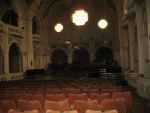
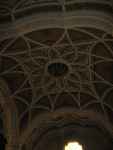
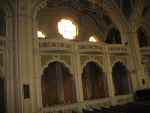
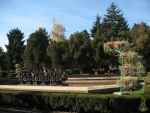
Tourists should not be afraid of taking taxis. They are cheep and it is, undoubtedly, better to pay some lei for the taxi and to reach the final destination safely. The travel from one particular point of the city to the most distant ones costs 10 lei maximally; for a distance of 3 kilometers the taxi fare will be about 5 lei.
While continuing their journey from Satu Mare the tourists can take advantage of a car, take a train (for instance a night train with couchettes from Bucharest costs 300-350 PLN), go by plane (a flight costs the same price if booked in advance) or take a bus (they drive very fast causing a great number of accidents; so this would be an option for wanderers looking for real challenges to be faced or for people with suicidal inclinations). Hitchhiking also comes into play but one must be aware that they will sometimes have to pay for this kind of transportation as it is the case in Albania.
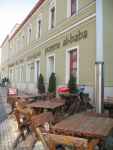
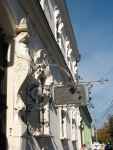
As far as food and Romanian cuisine are concerned, it would be recommended to go to a restaurant or a pizzeria. The food is really delicious, served mostly in large amounts and it is much cheaper than in Western Europe. In Satu Mare, the restaurant Poezis (Str. Mirecea Cel Mare) is said and known to be one of the nicer ones and, without a shadow of the doubt, one of the most beautiful ones. The cost of a popular menu of the day (a soup + the second course) is the equivalent of the 3€.
As far as pizzerias are concerned, we would highly recommend the Ali Baba (near to the promenade leading from the Liberty Square to the Administrative Palace).While being inside and waiting for the big and delicious pizza the tourists can delight themselves in the collection of handcrafts (mostly the ceramic). A big pizza (big enough for two persons) costs the equivalent of 4-7€.
Oficjalne dane z 2002 roku podają około 115 tysięcy mieszkańców, ale w ostatnich latach Satu Mare wchłonęło część okolicznych wsi i obecnie ilość mieszkańców szacuje się na około 130 tysięcy.
Rumunia - przewodnik:
Satu Mare / Satmar (Romania) – guidebook (52 zdjęcia)Săpânţa - The Merry Cemetery (Romania) – guidebook (35 zdjęć)Bârsana Maramureş (Romania)– guidebook (48 zdjęć)Humor / Mănăstirea Humorului and Voronet / Voroneţ (Romania) – guidebook (32 zdjęcia)Arbore and Sucevita Monastery / Mănăstirea Suceviţa (Romania) – guidebook (43 zdjęcia)Cacica (Romania) – guidebook (21 zdjęć)Vama Veche (Romania) – guidebook (94 zdjęcia)Brasov (Romania) – guidebook (68 zdjęć)Curtea de Argeş (Romania) – guidebook (31 zdjęć)The Transfagarasan Road / Transfăgărăşan – guidebook (68 zdjęć)Sibiu / Hermannstadt (Romania) – guidebook (86 zdjęć)Hunedoara / Vajdahunyad (Romania) – guidebook (57 zdjęć)Bear Cave / Peştera Urşilor (Romania) – guidebook (29 zdjęć)Ştefan Hruşcă – kolędnik z SiedmiogroduSighetu Marmației (Romania) – guidebook (9 zdjęć)Kościoły Obronne Siedmiogrodu (Rumunia) – przewodnik (25 zdjęć)Rimetea / Torocko at the Rock of Szeklers (Romania) – guidebook (21 zdjęć)Konstanca / Constanța (Rumunia) – przewodnik (22 zdjęcia)Sighișoara (Romania) – guidebook (28 zdjęć)Mărginimea Sibiului (Romania) – guidebook (41 zdjęć)Wąwóz Galbeny / Cheile Galbenei (Rumunia) – przewodnik (23 zdjęcia)Twierdza Ponoru / Cetatile Ponorului (Rumunia) – przewodnik (19 zdjęć)Płaskowyż Padisz / Padiș (Rumunia) – przewodnik (52 zdjęcia)Wąwóz Râmeț / Cheile Râmețului (Rumunia) – przewodnik (29 zdjęć)Góry Fogaraskie – wokół jeziora Bâlea (Rumunia) – przewodnik (24 zdjęcia)